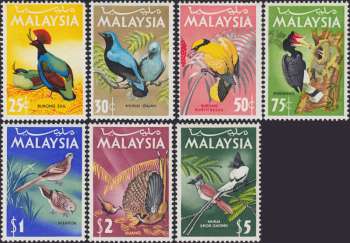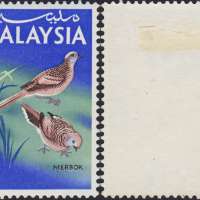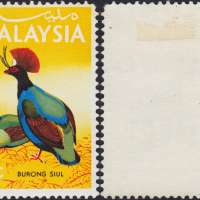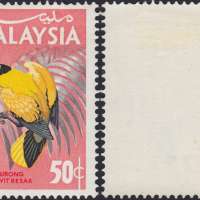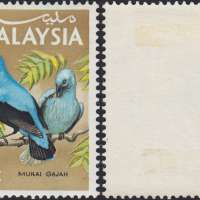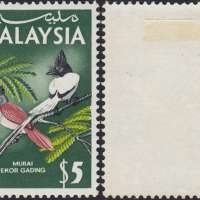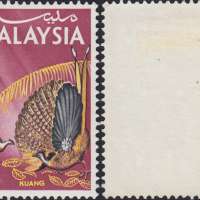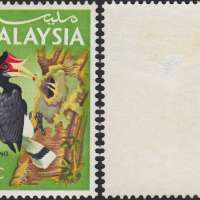STAMP PHILATELY
Malaysia - National Series : Birds (1965) Short Set
GENERAL INFORMATION
Country
Malaysia
Type
Stamp (Complete Set)
Class
Definitive / Regular Issues
Front Inscription
MALAYSIA مليسيا
Issued Date
09/09/1965
Designer
Alec Frederick Fraser-Brunner
Printer
Harrison & Sons Limited
Printing Method
Photogravure
Gum
Gum
Perforation Gauge
14½
Perforation Type
Normal Perforations
IN COLLECTION CONDITION
Preliminary
Normal
Condition
Mint Hinged - Very Fine
CATALOG INFORMATION
19
Standard Stamp Catalog of Malaysia, Singapore & Brunei
20
Standard Stamp Catalog of Malaysia, Singapore & Brunei
21
Standard Stamp Catalog of Malaysia, Singapore & Brunei
22
Standard Stamp Catalog of Malaysia, Singapore & Brunei
23
Standard Stamp Catalog of Malaysia, Singapore & Brunei
24
Standard Stamp Catalog of Malaysia, Singapore & Brunei
25
Standard Stamp Catalog of Malaysia, Singapore & Brunei
Malaysia - National Series : Birds (1965) Short Set
This is a short set, missing one piece with face value $10.

Orchid and Bird Definitives,1965
During 1965 Malaysia issued its first definitive stamps. The stamps featured orchids for the State low values and birds for the Malaysia high values. Each State had its own set, identical with the exception of the State name and Rulers portrait or State crest as applicable. The eight high values were printed in portrait format, featuring Malaysian birds, and had 'MALAYSIA' printed on them in place of State names.
Malaysia Medium and High Values
Eight values were issued for the medium and high values featuring Malaysian birds. The values were 25 cents, 30 cents, 50 cents, 75 cents, $1, $2, $5 and $10 and were intended for use in any Malaysian State. As with the low values, they were printed in two panes of 100, 10 x 10 with cylinder numbers 1A and 1B for the left and right pane, watermarked 'Multiple PTM upright' perforated 14 1/2. Various proofs exist showing the individual colours and combined up to full colour proofs. In addition, each value was produced on Harrison proof cards in full colour. As with the low values, missing colours can be found on a few values and inverted watermarks on the 25 cents, 30 cents, 50 cents, $1, $2 and $5 values.
25¢ BURONG SIUL
CRESTED GREEN WOOD-PARTRIDGE
Rollulus roulroul
Small parties of these birds are not uncommon in dry lowland jungle and on well drained slopes in the hills throughout Malaysia. They feed on the ground, rarely flying for more than short distances. The call is a low melodious whistle, which rings through the trees, and gives rise to the common Malay name.
Nest is a thick bed of dry leaves, eggs white, averaging 1.45 by 1.20 ins.
30¢ MURAI GAJAH
THE FAIRY BLUEBIRD
Irena puella malayensis
A common and showy bird of the tree-tops in lowland and hills forest throughout Malaysia, where the brilliant blue of the male in flight, is a memorable sight. The normal call is a melodious double whistle - "wit-wiu". Not gregarious, but usually associated in pairs, whose movement is largely influenced by the seasonal fruiting of the trees on which they feed.
Nests are of untidy cup made of twigs, placed high up in trees.
50¢ BURONG KUNYIT BESAR
THE BLACK-NAPED ORIOLE
Oriolus chinensis maculatus
Essentially a bird of the towns and gardens of Western Malaysia, never seen in our native forests, and absent from the Borneo States.
Usually seen in the canopies of trees, where they feed on fruit, rarely descending to the ground. Flight is strong and direct, usually at tree-top level. The familiar call, frequently uttered, is a beautiful whistle - "ta-kee-you" (sometimes omitting the first syllable). The nest is commonly slung in a fork, far out on a slender branch sixty or seventy feet up in a tall tree, in park-land or orchard. It is composed of bark, twiglets, grass and roots. The colour of the egg is white, tinged with violet, sparsely spotted and blotched with purple-brown - measuring 1.27 by 0.8 ins.
75¢ ENGGANG
THE RHINOCEROS HORNBILL
Buceros rhinoceros
This magnificent bird is restricted to the tall forest of our lowlands and foothills , and because of its specialized habits is unfortunately severely threatened by expanding rural development. Where it survives it can be seen feeding on the fruits of tall trees, its normal diet. The call rather goose-like, honk. is often uttered antiphonally by a pair of birds in flight. Normally associated in pairs or small family groups, occasionally forming small flocks.
As among all hornbills, the female remains in the nest hole, the entrance to which is partially closed by a plaster of mud, during the process of incubation and for some considerable time after the eggs have hatched, being fed by the male.
Birds abound in folklore and poetry:
$1 MERBOK
THE BARRED GROUND-DOVE
Geopelia striata
A common bird of open country and villages, and a favourite pet of Malaysians. Regular contests are held when the singing powers of caged birds are matched, and large side-bets may be placed. In the wild, these doves feed mostly on the ground.
Nests are small and flimsy platforms of stick built in trees. Eggs white, measuring 0.9 by 0.65 ins.
$2 KUANG
ARGUS PHEASANT
Argusianus argus
An inhabitant of tall forest, preferring the well drained slopes of the foothills, throughout Malaysia. Shy and seldom seen, but usually betrayed by its powerful call, either a double - "wak-wau", or a long series of plaintive single notes, each rising imperceptibly in tone.
The males maintain so-called "dancing-ground", small clearings which are kept scrupulously clean and free from debris, to which they repair to call and display. This habit renders the Argus Pheasant vulnerable to poachers, and already over much of Malaysia, this unique and beautiful bird has disappeared from its ancient haunts.
$5 MURAI EKOR GADING
PARADISE FLYCATCHER
Terpsiphone paradisi affinis
This beautiful bird is found in the forest of lowlands and foothills throughout the country. In flight the long tail-streamers of the male flutter like a length of still ribbon.
Nests usually are placed about six feet from the ground in a fork of a slender sapling. They are deep cups of moss, lined with dead grass or fibre. The eggs are glossy, the ground colour is faintly pink, sparsely spotted with reddish-brown and blotched with salmon-pink, measuring about 0.8 by 0.6 ins.
MISSING PIECE
$10 BURONG PACHAT
THE BANDED PITTA
Pitta guajana
Pittas are shy birds of the forest floor and undergrowth, disappearing with a flash of brilliant colour at the least sign of danger.
The Banded Pitta is not uncommon locally in the drier lowland jungle of the north. It appears to prefer the vicinity of limestone hills (probably because of the profusions of small snails on which it feeds).

Orchid and Bird Definitives,1965
During 1965 Malaysia issued its first definitive stamps. The stamps featured orchids for the State low values and birds for the Malaysia high values. Each State had its own set, identical with the exception of the State name and Rulers portrait or State crest as applicable. The eight high values were printed in portrait format, featuring Malaysian birds, and had 'MALAYSIA' printed on them in place of State names.
Malaysia Medium and High Values
Eight values were issued for the medium and high values featuring Malaysian birds. The values were 25 cents, 30 cents, 50 cents, 75 cents, $1, $2, $5 and $10 and were intended for use in any Malaysian State. As with the low values, they were printed in two panes of 100, 10 x 10 with cylinder numbers 1A and 1B for the left and right pane, watermarked 'Multiple PTM upright' perforated 14 1/2. Various proofs exist showing the individual colours and combined up to full colour proofs. In addition, each value was produced on Harrison proof cards in full colour. As with the low values, missing colours can be found on a few values and inverted watermarks on the 25 cents, 30 cents, 50 cents, $1, $2 and $5 values.
25¢ BURONG SIUL
CRESTED GREEN WOOD-PARTRIDGE
Rollulus roulroul
Small parties of these birds are not uncommon in dry lowland jungle and on well drained slopes in the hills throughout Malaysia. They feed on the ground, rarely flying for more than short distances. The call is a low melodious whistle, which rings through the trees, and gives rise to the common Malay name.
Nest is a thick bed of dry leaves, eggs white, averaging 1.45 by 1.20 ins.
30¢ MURAI GAJAH
THE FAIRY BLUEBIRD
Irena puella malayensis
A common and showy bird of the tree-tops in lowland and hills forest throughout Malaysia, where the brilliant blue of the male in flight, is a memorable sight. The normal call is a melodious double whistle - "wit-wiu". Not gregarious, but usually associated in pairs, whose movement is largely influenced by the seasonal fruiting of the trees on which they feed.
Nests are of untidy cup made of twigs, placed high up in trees.
50¢ BURONG KUNYIT BESAR
THE BLACK-NAPED ORIOLE
Oriolus chinensis maculatus
Essentially a bird of the towns and gardens of Western Malaysia, never seen in our native forests, and absent from the Borneo States.
Usually seen in the canopies of trees, where they feed on fruit, rarely descending to the ground. Flight is strong and direct, usually at tree-top level. The familiar call, frequently uttered, is a beautiful whistle - "ta-kee-you" (sometimes omitting the first syllable). The nest is commonly slung in a fork, far out on a slender branch sixty or seventy feet up in a tall tree, in park-land or orchard. It is composed of bark, twiglets, grass and roots. The colour of the egg is white, tinged with violet, sparsely spotted and blotched with purple-brown - measuring 1.27 by 0.8 ins.
75¢ ENGGANG
THE RHINOCEROS HORNBILL
Buceros rhinoceros
This magnificent bird is restricted to the tall forest of our lowlands and foothills , and because of its specialized habits is unfortunately severely threatened by expanding rural development. Where it survives it can be seen feeding on the fruits of tall trees, its normal diet. The call rather goose-like, honk. is often uttered antiphonally by a pair of birds in flight. Normally associated in pairs or small family groups, occasionally forming small flocks.
As among all hornbills, the female remains in the nest hole, the entrance to which is partially closed by a plaster of mud, during the process of incubation and for some considerable time after the eggs have hatched, being fed by the male.
Birds abound in folklore and poetry:
"Anak enggang di-kayu tinggi,
Patah ranting terbang-lah dia,
Anak dagang lama di-sini,
Sampai musim terbang-lah dia."
"On top of high tree the Enggang sits,
Away it flies when the branch breaks,
However long a foreigner may stay,
To his home land he will fly away."
Patah ranting terbang-lah dia,
Anak dagang lama di-sini,
Sampai musim terbang-lah dia."
"On top of high tree the Enggang sits,
Away it flies when the branch breaks,
However long a foreigner may stay,
To his home land he will fly away."
$1 MERBOK
THE BARRED GROUND-DOVE
Geopelia striata
A common bird of open country and villages, and a favourite pet of Malaysians. Regular contests are held when the singing powers of caged birds are matched, and large side-bets may be placed. In the wild, these doves feed mostly on the ground.
Nests are small and flimsy platforms of stick built in trees. Eggs white, measuring 0.9 by 0.65 ins.
$2 KUANG
ARGUS PHEASANT
Argusianus argus
An inhabitant of tall forest, preferring the well drained slopes of the foothills, throughout Malaysia. Shy and seldom seen, but usually betrayed by its powerful call, either a double - "wak-wau", or a long series of plaintive single notes, each rising imperceptibly in tone.
The males maintain so-called "dancing-ground", small clearings which are kept scrupulously clean and free from debris, to which they repair to call and display. This habit renders the Argus Pheasant vulnerable to poachers, and already over much of Malaysia, this unique and beautiful bird has disappeared from its ancient haunts.
$5 MURAI EKOR GADING
PARADISE FLYCATCHER
Terpsiphone paradisi affinis
This beautiful bird is found in the forest of lowlands and foothills throughout the country. In flight the long tail-streamers of the male flutter like a length of still ribbon.
Nests usually are placed about six feet from the ground in a fork of a slender sapling. They are deep cups of moss, lined with dead grass or fibre. The eggs are glossy, the ground colour is faintly pink, sparsely spotted with reddish-brown and blotched with salmon-pink, measuring about 0.8 by 0.6 ins.
MISSING PIECE
$10 BURONG PACHAT
THE BANDED PITTA
Pitta guajana
Pittas are shy birds of the forest floor and undergrowth, disappearing with a flash of brilliant colour at the least sign of danger.
The Banded Pitta is not uncommon locally in the drier lowland jungle of the north. It appears to prefer the vicinity of limestone hills (probably because of the profusions of small snails on which it feeds).
COMMENTS
NEW COMMENT
|
The following text must accompany any text or photo taken from this page and limited use for non-commercial purposes only.
Texts and Images were taken from and courtesy of Exonumi.com
URL: http://www.exonumi.com/publish-SP.1.712
|
|
